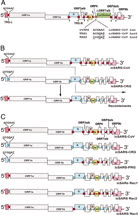Rewiring the severe acute respiratory syndrome coronavirus (SARS-CoV) transcription circuit: Engineering a recombination-resistant genome at Carolina Vaccine Center, University of North Carolina,
Live virus vaccines provide significant protection against many detrimental human and animal diseases, but reversion to virulence by mutation and recombination has reduced appeal.
Using severe acute respiratory syndrome coronavirus as a model, we engineered a different transcription regulatory circuit and isolated recombinant viruses. The transcription network allowed for efficient expression of the viral transcripts and proteins, and the recombinant viruses replicated to WT levels. Recombinant genomes were then constructed that contained mixtures of the WT and mutant regulatory circuits, reflecting recombinant viruses that might occur in nature. Although viable viruses could readily be isolated from WT and recombinant genomes containing homogeneous transcription circuits, chimeras that contained mixed regulatory networks were invariantly lethal, because viable chimeric viruses were not isolated. Mechanistically, mixed regulatory circuits promoted inefficient subgenomic transcription from inappropriate start sites, resulting in truncated ORFs and effectively minimize viral structural protein expression. Engineering regulatory transcription circuits of intercommunicating alleles successfully introduces genetic traps into a viral genome that are lethal in RNA recombinant progeny viruses.
